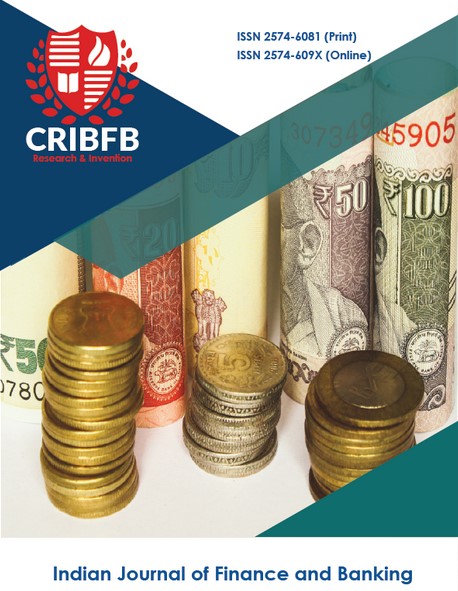IMPACT OF VALUE-ADDED TAX ON GROSS DOMESTIC PRODUCT OF BANGLADESH
Main Article Content
Abstract
International Monetary Fund advocates the Bangladesh government introduce Value Added Tax that was incepted in 1991. Before that, it was known as sales tax. Now Bangladesh scales up its country income status from a low-income country to a middle-income country, while value-added tax is the key player contributing a great part to gross domestic product. The study inspects the effect of value-added tax on Bangladesh's gross domestic product using a long dataset from 1991-1992 to 2020-2021. The study uses a co-integration technique invented by Johansen with a restricted V.A.R. named vector error correction model. This article finds that value-added tax has a specific positive impact on a gross domestic product that ensures good and continuous economic growth over the decades in Bangladesh.
JEL Classification Codes: K34.
Downloads
Article Details
Section
How to Cite
References
Adegbie, F. F., Olajumoke, J., & Danjuma, K.J. (2016). Assessment of value-added tax on the growth and development of Nigeria economy: imperative for reform. Accounting and Finance Research, 5(4), 163-178. https://doi.org/10.5430/afr.v5n4p163
Anojan, V. (2015). Value-added tax (V.A.T.), gross domestic production (G.D.P.), and budget deficit (B.D.): A case study in Srilanka. Proceeding of International Conference on Contemporary Management, (ICCM-2015), 1-11.
Ayoub, Z., & Mukherjee, S. (2019). Value Added Tax and economic growth: An empirical study of China perspective. Signifikan: Jurnal Ilmu Ekonomi, 8(2), 235-242.
Emran, M. S., & Stiglitz, J. E. (2005). On selective indirect tax reform in developing countries, Journal of Public Economics, 89, 599– 623. https://doi.org/10.1016/j.jpubeco.2004.04.007
Emmanuel, U. C. (2013). Accumulation of external reserves and effects on exchange rates and inflation in Nigeria. International business and management, 6(2), 105-114.
Faridy, N., & Sarker, T. (2011). Incidence of Value Added Tax (Vat) in the Developing Countries: A Case in Bangladesh. International Journal of Trade, Economics and Finance, 2(5), 437-442. https://doi.org/10.1016/10.7763/IJTEF.2011.V2.145
Fjeldstad, O. H. (2014). Tax and development: Donor support to strengthen tax systems in developing countries. Public Administration and Development, 34(3), 182-193. https://doi.org/10.1002/pad.1676
Gatawa, N. M., Abdulgafar, A., & Olarinde, M. O. (2017). Impact of money supply and inflation on economic growth in Nigeria (1973-2013). IOSR Journal of Economics and Finance (IOSR-JEF), 8(3), 26-37.
Gashi, B., Asllani, G., & Boqolli, L. (2018). The Effect of Tax Structure in Economic Growth. International Journal of Economics & Business Administration (I.B.A.), 6(2), 56-67.
Jalata, D. M. (2014). The role of value added tax on economic growth of Ethiopia. Science, Technology and Arts Research Journal, 3(1), 156-161.
Kalaš, B., & Milenković, N. (2017). THE ROLE OF VALUE ADDED TAX IN THE ECONOMY OF SERBIA. Ekonomika, 63(2), 69-79.
Lalarukh, F., & Chowdhury, M. S. (2013). Contribution of V.A.T. to the G.D.P. of Bangladesh: A Trend Study. Journal of Business Studies, 34(2), 131-141.
Michael, O. B. (2013). Taxation and tax policy as government strategy tools for economic development in Nigeria. Journal of Business and Management, 13(5), 34-40.
Musgrave, R. A. (1969). Cost-benefit analysis and the theory of public finance. Journal of Economic Literature, 7(3), 797-806.
Nashashibi, M. K. A. (2002). Fiscal Revenues in South Mediterranean Arab Countries: Vulnerabilities and Growth Potential. I.M.F. Working Papers, (2002/067).
Nasiru, M. G., Haruna, M. A., & Abdullahi, M. A. (2016). Evaluating the impact of value added tax on the economic growth of Nigeria. Journal of Accounting and Taxation, 8(6), 59-65.
Okoye, E. I., & Gbegi, D. O. (2013). Effective value-added tax: An imperative for wealth creation in Nigeria. Available at SSRN 2238854.
Onwuchekwa, J. C., & Aruwa, S. A. (2014). Value-added tax and economic growth in Nigeria. European Journal of Accounting Auditing and Finance Research, 2(8), 62-69.
Rahman, Z. U., & Sarkar, S. H. (2021). Role of Value Added Tax (V.A.T.) on the Economic Growth of Bangladesh, IOSR Journal of Business and Management (IOSR-JBM), 23(02), 12-27
Shala, T. (2021). Collection of Value Added Tax in Kosovo and Its Effect on Economic Growth. European Journal of Economics and Business Studies, 3(2), 225-233.
Stoilova, D., & Patonov, N. (2013). An empirical evidence for the impact of taxation on economic growth in the European Union. Tourism & Management Studies, Tourism & Management Studies, 3, 1031-1039.
Simionescu, M., & Albu, L. L. (2016). The impact of standard value-added tax on economic growth in CEE-5 countries: econometric analysis and simulations. Technological and Economic Development of Economy, 22(6), 850-866.




